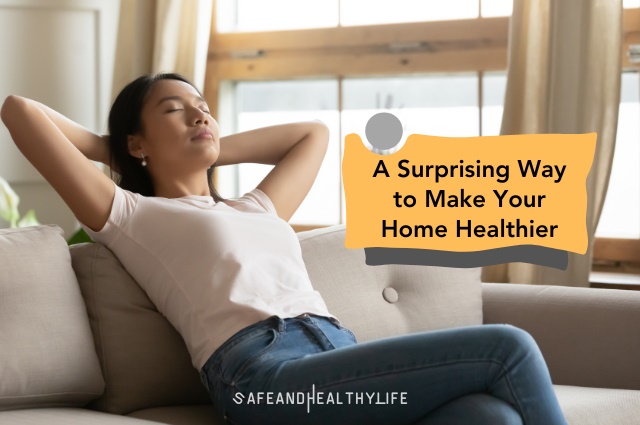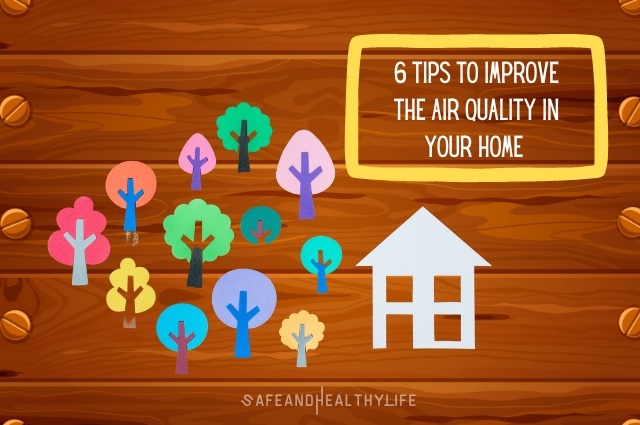
We all know that a huge part of staying healthy is considering what we actively put in our bodies – how they will fuel us and help us stay fit and strong. But we often forget that there are things that passively enter our bodies that contribute to our overall health, as well.
The average person takes around 20,000+ breaths a day which means that the quality of our air can directly impact the quality of our health.
And since most of us take a lot of those breaths at home, it makes sense to pay attention to the things we bring into it and how they impact our air quality.
What’s the problem?
Cigarette smoke is an obvious contributor to unhealthy air but you may be surprised to know that your furniture, finishes, and other household products can also negatively impact your health, as well.
Many household items emit Volatile Organic Compounds or VOCs that can be detrimental to important bodily functions.
In the short term, VOCs can cause symptoms such as headaches, and irritation to your skin, eyes, nose, and throat. In the longer term, VOCs are suspected or known to cause more serious health problems like cancer.
Who is the most impacted by VOCs?
While VOCs aren’t great for anyone, there are some groups with a higher chance of a negative outcome after exposure.
They include:
- People with compromised immune systems – Anyone whose immune system is weakened is more susceptible to the negative effects of VOCs.
- People with asthma or other respiratory conditions – Someone whose lungs are already strained has a high likelihood of experiencing even more ill effects when VOC exposure is layered on top of their existing condition.
- Individuals with allergies – People with allergies or chemical sensitivities can have an allergic reaction when exposed to VOCs.
- Workers who spend prolonged hours indoors – since indoor air quality can often be worse than outdoor air quality, spending all day in an office can increase your exposure and risk.
- Expecting mothers – The risk of exposure to many harmful substances is greater during pregnancy and VOCs are no exception.
- Children – Because they have higher respiratory rates, children can be at greater risk of negative side effects of VOCs.
- Older adults – Some older adults have weakened immune systems which can make them more susceptible to respiratory irritants.
Despite the potential negative impacts on so many people, it’s not all doom and gloom. With a little bit of knowledge, there are plenty of ways you can limit your exposure to VOCs in your home.
6 tips to improve the air quality in your home

1. Make your cleaning routine a little cleaner
Choose natural cleaning products whenever possible since toxic cleaning products can be a leading cause of VOC exposure. Often, things like white vinegar, baking soda, and lemon juice are more effective than the costlier, toxic cleaning products you buy in the store.
There are also great, non-toxic offerings from companies like Grove Collaborative. For more information on green cleaning, check out our recent infographic!
2. Get all the information before you buy furniture
Lookout for 3rd party certifications like GREENGUARD and GREENGUARD GOLD, or OEKO-TEX® that verify that the furniture you are considering for your home is a better choice.
Luckily, there’s never been a better time to find beautiful and safe furniture options for your home. While many of the tried and true furniture manufacturers are switching to less toxic options (look for those certifications) there are also newer companies like Avocado, Sabai, and Burrow that specialize in non-toxic and sustainable options.
3. Better yet, buy vintage!
One of the easiest and most cost-effective ways to reduce your VOC exposure risk is to buy pre-owned. Furniture generally does the majority of its “off-gassing” right after a piece of furniture is made, used furniture can be a safer choice when it comes to VOC emissions.
These days, there are so many great and easy ways to find used furniture for your home. Facebook Marketplace can help you find great deals near you, but you will most likely need to do the legwork to see a piece in person and haul it home yourself.
If it’s a large item and you don’t have the manpower or vehicle to haul it, there are other options. Online sellers like Kaiyo, AptDeco, 1stDibs, and Chairish make it easy to find vintage items and do the work of getting them to you. Many of these online sellers will have the item professionally cleaned, too!
4. Avoid that new house smell
That “new house smell” can often be the scent of harmful substances used in construction. There are so many low and no-VOC paint options available – asking for this option the next time you purchase house paint is an easy step to take.
Other things like wood finishes and flooring can be a little sneakier. In all cases, look for certifications, ask questions, and avoid materials such as formaldehyde and vinyl that are known to be particularly toxic.
5. Air it out
It’s surprising but often indoor air quality can be worse than outdoor air quality. This makes it important to make sure that your home is properly ventilated. There are many ways to make sure the air in your home is sufficiently circulating with fresher, outdoor air.
One important practice that can help reduce harmful VOCs in your home is running a vent in the kitchen and bathroom. You may have read about the hazards of gas stove cooking but any type of cooking can emit smoke and other bi-products that aren’t great for your lungs. Running a fan in the bathroom is also a good idea as it helps reduce moisture and prevent mold growth.
If you’re concerned that your house may not have sufficient ventilation, you may want to consult an HVAC professional. They’ll be able to tell you how sufficiently your current system is ventilating and your best options for additional mechanical ventilation.
Finally, regularly opening windows and doors is a low-tech solution to practice, as long as there are no outdoor air quality warnings. Don’t hesitate to commune with nature a bit on that next nice, breezy day.
6. Take precautions while cooking
Surprisingly, cooking that wholesome family meal (or any meal) can be a contributor to poor air quality in your home.
This can come from the ingredients you use like aerosol cooking sprays, the tools you use such as non-stick cookware, and the temperature at which you cook.
(hint: slow and steady wins the race!)
Try using a lower temperature, with stainless steel or cast iron cookware, and non-aerosol products. If you’re in the market for a new stove, consider electric or induction rather than a gas stove.
You may have heard the buzz, but a recent increase in knowledge about the hazards of gas stoves to human health makes reducing exposure well worth it. If nothing else, make sure you are running an exhaust fan while cooking.
An ounce of prevention…
Learning that there are hidden toxins in our home can be a little scary but with a little bit of knowledge and effort, it’s possible to reduce your exposure.
Doing a little bit of research on the furniture, materials, and cleaners you bring into your home can help you make sure you’re making the best choices for the health of everyone you live with.
About The Author:
Amy Kleppinger is a writer and businesswoman with a passion for both the great outdoors and interior design. In 2022, she brought these loves together to create The Home Green: a resource for anyone interested in making the place they live a little bit greener. She hopes you’ll check it out.
Sources:
https://www.epa.gov/indoor-air-quality-iaq/what-are-volatile-organic-compounds-vocs
https://www.sciencedirect.com/science/article/abs/pii/S0013935103000355
https://iaqscience.lbl.gov/vocs-cleaning-products
https://www.epa.gov/indoor-air-quality-iaq/volatile-organic-compounds-impact-indoor-air-quality
https://www.greenbuildingsupply.com/Learning-Center/Flooring-LC/Why-we-dont-sell-luxury-vinyl-tile
https://www.gethealthyhome.com/blog/how-cooking-can-harm-your-homes-indoor-air-quality
https://www.scientificamerican.com/article/the-health-risks-of-gas-stoves-explained

![[Infographic] The Surprising Connection Between Gut Health And Your Hair Connection Between Gut Health And Your Hair](https://www.safeandhealthylife.com/wp-content/uploads/2023/10/Connection-Between-Gut-Health-And-Your-Hair-150x150.webp)


